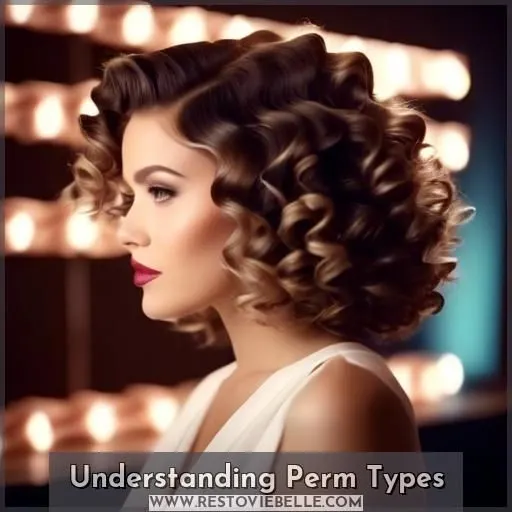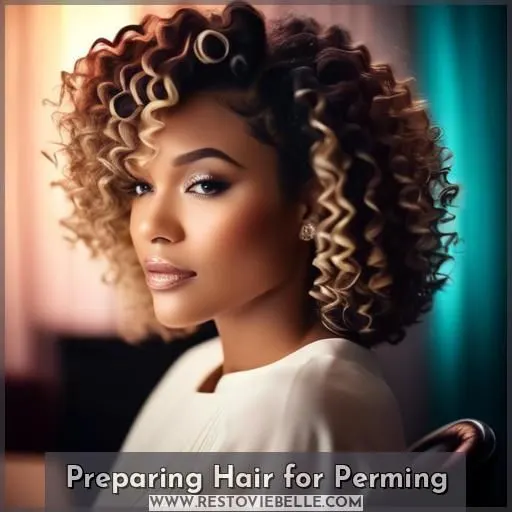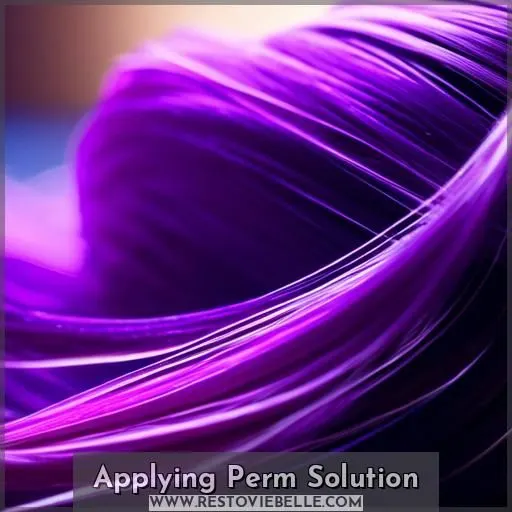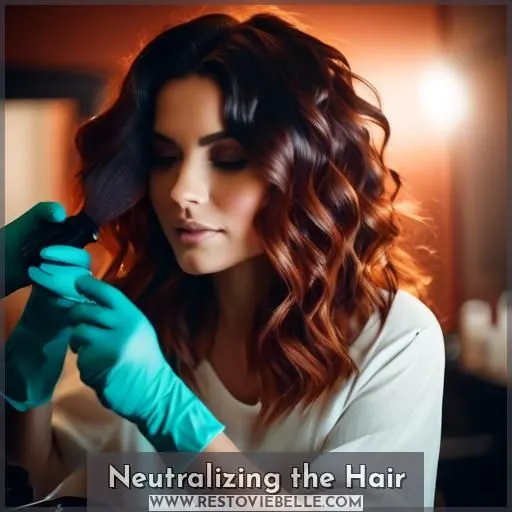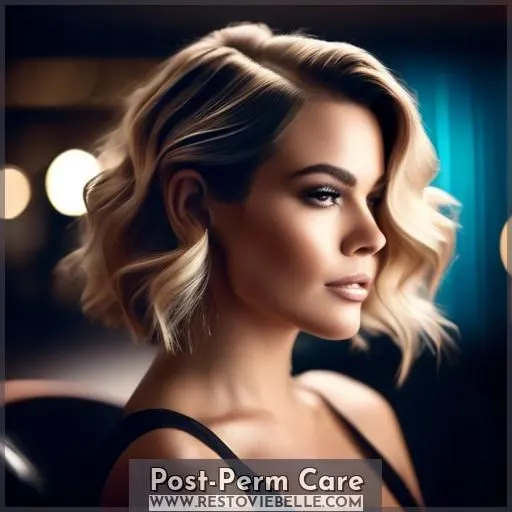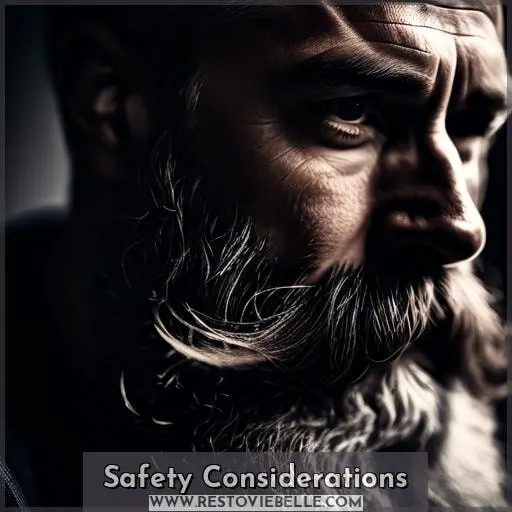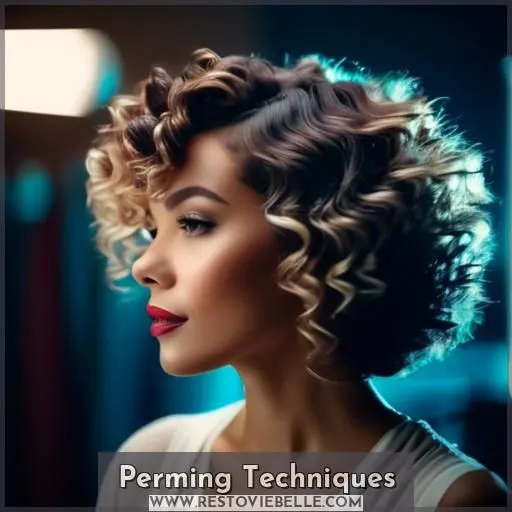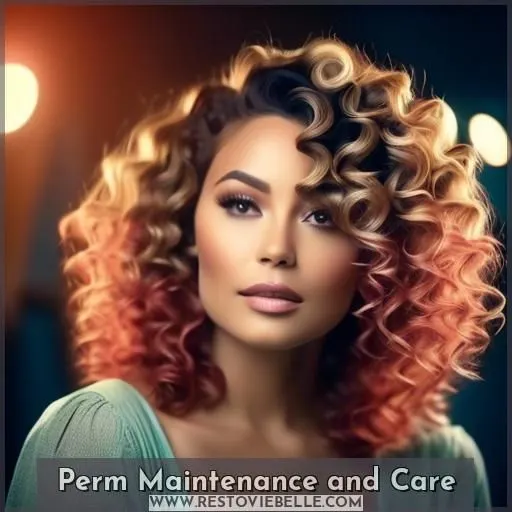This site is supported by our readers. We may earn a commission, at no cost to you, if you purchase through links.
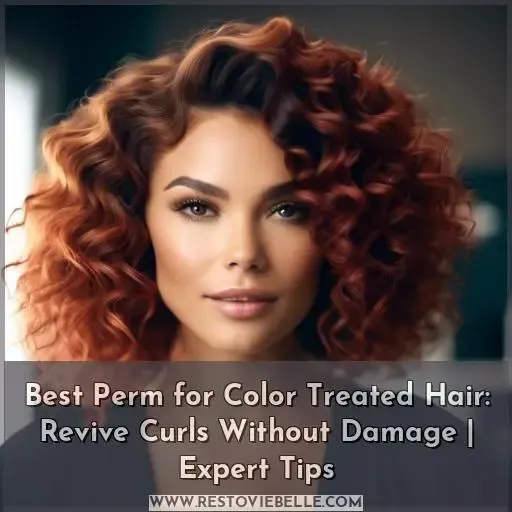
You’ll want to choose a thio-free, gentle perm solution designed specifically for color-treated hair like Zotos Texture EFX Color Perm Treated.
Its cysteamine formula and odor-neutralizing system help prevent damage and balance porosity, leaving your colored locks healthy-looking and conditioned.
Redken’s Bonding Conditioner and Ogilvie’s Professional Perm are also excellent options customized for dyed hair.
Proper preparation, application method, and post-perm care are essential for bouncy, long-lasting curls without sacrificing your vibrant hues.
Want to learn more strategies for achieving fabulous, frizz-free curls that complement your color?
Table Of Contents
Key Takeaways
- Choose a thio-free, gentle perm solution designed for color-treated hair, such as Zotos Texture EFX Color Perm Treated, which has a cysteamine formula and odor-neutralizing system to prevent damage and balance porosity.
- Redken Bonding Conditioner and Ogilvie’s Professional Perm are also excellent options for color-treated hair, offering versatile benefits like vegan and sulfate-free formulas, all-in-one repair, and protection against damage.
- Proper preparation, application method, and post-perm care are crucial for achieving bouncy, long-lasting curls without sacrificing vibrant hues.
- Understanding perm types, such as body wave, spiral, and spot perm, can help you choose the best option for your hair type and desired look.
Top 3 Perms for Color-Treated Hair
If you have color-treated hair and want to add some gorgeous waves or curls, you’re in luck.
There are perming options that can give you beautiful, bouncy results without damaging your strands.
The top three perms for color-treated hair are:
Zotos Texture EFX Color Perm Treated
Redken Bonding Conditioner for Damaged Hair
Ogilvie Salon Styles Professional Perm for Color Treated Hair
1. Zotos Texture EFX Color Perm Treated
Zotos Texture EFX Color Perm Treated is one of the top perm options for color-treated hair. This thio-free, damage-free cysteamine perm offers a unique odor neutralizing system, leaving hair with a soft texture and touchable curls. It’s formulated to equalize porosity and guarantee even curl formation while leaving color-treated and previously permed hair healthy-looking and conditioned.
Best For: Color-treated hair that needs a perm without damage.
- Thio-free and damage-free cysteamine perm
- Odor neutralizing system
- Equalizes porosity for even curl formation
- Some customers have received damaged packaging
- Some customers have had difficulty achieving desired curl size
2. Redken Bonding Conditioner for Damaged Hair
If you’re looking for a conditioner that’s vegan and sulfate-free, the Redken Bonding Conditioner for Damaged Hair is a fantastic choice.
This all-in-one formula contains citric acid and Redken’s bonding care complex, which repairs damage, strengthens hair, and protects color.
It’s suitable for all types of damage and hair types, making it a versatile addition to your hair care routine.
The thick consistency means you’ll need less product, and it’s safe for color-treated hair.
Plus, it hydrates and moisturizes damaged or processed hair, preserving hair health from salon services.
Best For: Damaged hair of all types, including color-treated hair.
- Repairs damage, strengthens hair, and protects color.
- All-in-one formula with citric acid and bonding care complex.
- Thick consistency requires less product.
- May be more expensive than other conditioners.
- Not as readily available as other conditioners.
- May not be suitable for all hair types and damage levels.
3. Ogilvie Salon Styles Professional Perm for Color Treated Hair
If you’re seeking a perm option specifically designed for color-enhanced hair, you may wish to explore the Ogilvie Salon Styles Professional Perm for Color Enhanced Hair. This perm kit is formulated to offer gentle, effective salon outcomes at home, and it incorporates a pre-perm conditioner to safeguard your hair against dryness and frizz.
The Ogilvie Salon Styles Professional Perm is appropriate for all hair types, although it’s especially beneficial for color-enhanced hair. It’s a single-use item that promises to impart long-lasting curls and waves, and it’s heat-activated for greater ease.
The kit consists of a curling lotion with a refreshing fragrance, an instant crème neutralizer, and a leave-in conditioner to aid in balancing your hair’s moisture content. It’s noteworthy that the Ogilvie Salon Styles Professional Perm isn’t suitable for hair that has been highlighted, frosted, bleached, or previously straightened with relaxers containing lye or guanidine carbonate.
Remember to thoroughly review the instructions prior to using the product, and consistently adhere to the manufacturer’s guidelines for optimal results.
Best For: Those seeking a gentle and effective perm for color-treated hair.
- Gentle formula for salon-quality results at home
- Includes pre-perm conditioner to protect hair from dryness and frizz
- Long-lasting smooth curls and waves
- Not recommended for individuals with arm problems
- May cause hair breakage or dryness in some individuals
- No French instructions included
Understanding Perm Types
You’re likely aware of the classic body wave perm that creates soft, natural-looking waves.
But have you considered a spiral perm for tighter, corkscrew-like curls?
Or perhaps a spot perm, which allows you to curl just specific sections of your hair?
These different perm types offer versatility to achieve your desired look while catering to your hair’s unique texture and condition.
Body Wave Perm
Body Wave Perm is perfect for those seeking loose, natural-looking waves.
It’s suitable for fine hair and resistant hair, offering a soft and natural feel.
It’s also a great option for color-treated and bleached hair, as it doesn’t damage the hair structure.
However, it may not be ideal for curly hair or those desiring tight curls.
Always consult a hair expert before perming to ensure safety and the best possible results.
Spiral Perm
Spiral Perms, also known as corkscrew curls, are a popular perm option for those seeking tight, defined curls.
These perms are created using perm rods and involve a process called exothermic waving, which uses heat to create defined, coily curls.
Cysteamine waves are another option for creating spiral curls, offering versatility for normal to resistant or color-treated hair.
To achieve the best results, it’s critical to understand the different perm types and follow the correct techniques, such as towel blotting, using the appropriate perm solution, and proper neutralization.
The key to a successful spiral perm is patience and precision.
Spot Perm
Spot Perm is a type of perm that allows you to create curls in specific sections of your hair. This technique is perfect for those who want a more customized look without the commitment of a full perm. Here are some key points to keep in mind when choosing a spot perm:
- Perm duration: The length of time your curls will last depends on the type of perm solution used and the condition of your hair.
- Perm maintenance: Regular trims and touch-ups may be necessary to maintain your curls.
- Perm damage: Over-processing can lead to damaged hair, so it’s critical to follow the instructions carefully.
- Perm types: There are various perm types, such as acid, alkaline, and exothermic waves, each with its own benefits and drawbacks.
- Perm cost: The cost of a spot perm can vary depending on the salon and the type of perm solution used.
- Chunk test: Always do a chunk test before the actual perm to make sure the perm solution is suitable for your hair.
- Porosity equalizer: Use a porosity equalizer to guarantee even penetration of the perm solution into your hair.
- Processing cap: Use a processing cap to prevent the perm solution from coming into contact with your scalp.
- Perm solution: Choose a perm solution that’s suitable for your hair type and condition.
- Best perm for color-treated hair: Opt for a perm solution that’s specifically designed for color-treated hair to avoid damage.
Preparing Hair for Perming
Before perming color-treated hair, you’ll want to shampoo it thoroughly to remove any product buildup or residue that could interfere with the perming process. Once shampooed, towel blot your hair to remove excess moisture, as damp hair allows for better penetration of the perming solution.
Shampooing the Hair
Before delving into the realm of hair perming, consider your hair as a canvass that necessitates preparation. Shampooing isn’t merely a matter of hygiene; it entails purging the old to receive the new. By eliminating surface impurities, you’re guaranteeing that the perming solution, be it acid or cysteamine-based, can profoundly penetrate, laying the groundwork for those vibrant curls you envision.
Towel Blotting
To guarantee your hair is primed for a perm, it’s imperative to pat dry excess water with a towel before winding it around the rods.
This step is essential for multiple reasons.
Primarily, it aids the perm solution in penetrating more efficiently into the hair shaft, which is paramount for achieving the desired curl.
Subsequently, patting dry removes moisture, facilitating even application of the perm solution.
Finally, it averts the solution from being weakened by excess water, which could impact the final result.
To pat dry, gently press a towel against your hair to remove moisture without rubbing or causing friction, as this can cause damage.
Applying Perm Solution
When applying the perm solution, use large benders to create loose, beachy waves that won’t damage color-treated hair. Avoid excessive tension while wrapping the hair around the rods, as this can cause breakage and uneven results.
Using Large Benders
Using large rollers, also known as perm rods, is a key step in the perm process. The size of the roller you choose can greatly affect the curl definition and elasticity. Larger rollers, such as 9/16-inch perm rods, create firm, bouncy curls for any hair length, while smaller rollers, like 3/8-inch perm rods, produce tight curls and flowing coils.
When applying perm solution, it’s important to maintain tension levels and hair wrapping methods to achieve even penetration of the solution. For beachy waves, you can use large rollers, like the Wavy 8’s tool, which consists of two rollers connected with an elastic rubber hair band at one end.
To create loose waves, use larger conventional perm rods to create less defined ends. The aim is to follow the parietal ridge during the wrapping process. Remember to maintain the vertical weaving to achieve the desired curl definition.
When wrapping the hair around the rollers, weave the hair over the right side roller away from the face, under, then back through the center, and over the left side and through the center again, making a figure 8. This technique helps in creating a balanced curl pattern.
Avoiding Excessive Tension
Avoid excessive tension when wrapping your hair around the perm rods to prevent damage and guarantee soft waves. Always use a tension management technique, such as gently pulling the hair away from the scalp, and avoid pulling or stretching the hair. This will help maintain the health and integrity of your hair during the perming process.
Neutralizing the Hair
After the perm solution has processed for the recommended time, you’ll need to neutralize the hair to lock in those beautiful curls.
Carefully remove the perm rods.
Then apply the neutralizing solution evenly from roots to ends, leaving it on for 5 minutes as directed – not more, not less.
This vital step stops the chemical process and prepares your hair for gorgeous, long-lasting results.
Leaving Neutralizer On
Leaving the neutralizer on for the specified time is critical for the effectiveness of your perm.
The neutralizer is responsible for reconstructing the disulfide bonds of your hair, which have been weakened by the perming solution. It’s necessary to adhere to the instructions meticulously to avoid harm to your hair.
The most prevalent neutralizer used in perms is hydrogen peroxide, which remains on the hair for approximately 5 minutes. Prolonged application can lead to hair damage, including swelling of the cuticle layer and increased susceptibility to damage.
To attain optimal results, rinse your hair thoroughly after applying the neutralizer and wait for the specified time before removing the rods.
Removing Rods
After the neutralizer has worked its magic for five minutes, it’s time for the grand reveal.
Gently remove the rods, a technique akin to unwrapping a gift, to avoid tugging at your newly curled tresses.
Patience is key during hair drying to maintain those bouncy curls.
Now, you’re set for post-perm styling, stepping into a world of voluminous freedom and effortless flair.
Post-Perm Care
After your perm, you’ll want to avoid brushing your hair for at least 48 hours to allow the new curl pattern to set and the chemical bonds to solidify. It’s also best to wait about a week before coloring your hair, as perming can make the hair more porous and susceptible to damage from the coloring process.
Not Brushing Hair
After your perm, it’s essential to refrain from brushing your hair for at least 48 hours.
This allows the bonds to solidify without causing harm or breakage.
Brushing can also result in scalp irritation, allergic reactions, or even chemical burns.
Instead, carefully detangle your hair with a wide-toothed comb or your fingers.
Color Treatment After Perm
After receiving a perm, it’s essential to wait a week before coloring your hair to prevent damage.
Neutralizer is vital for post-perm care, but bear in mind not to leave it on for more than 5 minutes.
Utilize a wide-tooth comb to avert frizz.
For harmless perms, opt for products that are thio-free and mild on your hair.
Consistently prioritize hair well-being over a hasty solution.
Safety Considerations
Perming colored or bleached hair necessitates additional safeguards to avert further harm and maintain the well-being of the hair strands. When perming previously injured hair, it’s imperative to confer with a skilled stylist and contemplate more benign, ammonia-free perm formulations tailored explicitly for delicate, chemically treated locks.
Perming Colored or Bleached Hair
Perming colored or bleached hair isn’t inherently dangerous, but it’s not recommended.
Chemical processes can damage hair, and perming colored hair may lighten the color.
Milder perming formulas are available for colored hair.
Always consult a hair expert before perming.
Post-perm care is essential for damage repair.
Use sulfate-free and paraben-free shampoo.
Deep condition and use hair masks regularly.
Go for hair spa sessions to maintain healthy hair.
Perming Damaged Hair
In the realm of perming damaged tresses, it’s imperative to weigh the hair’s porosity, as it profoundly affects the outcome and potential harm of the process. High porosity hair, vulnerable to environmental stressors, may necessitate a distinct approach from low porosity hair. It’s paramount to select a perming technique tailored to your hair’s unique needs, mitigating damage and maximizing the chances of a flawless perm.
For damaged hair, it’s prudent to choose a perming method that minimizes harm, such as an acid perm or a root perm. These options harness gentler chemicals and target specific hair sections, reducing overall chemical exposure and potential damage. Moreover, meticulous aftercare is paramount to preserving the health of your hair post-perm, including utilizing sulfate-free shampoos, indulging in deep conditioning treatments, and abstaining from heat styling.
Perming Techniques
You’ll need a different approach when perming longer or resistant hair textures.
For stubborn strands, opt for an exothermic perm like Design Freedom Exo, which contains Isoamine™ waving lotion.
It strengthens and restructures hair bonds for long-lasting, defined curls.
When working with extra-long tresses, go for a specialized perming technique that wraps hair snugly around larger perm rods.
This creates full, bouncy waves from roots to ends.
Perming Longer Hair
Perm longer hair with care and delicacy to ensure curls stay intact without damaging the hair.
Begin by selecting a perm solution with a longer perm duration and higher potency.
Exothermic advantages offer a tighter curl.
If you have extensions, protect them during the perming process.
After perming, be gentle with your roots.
Avoid touching them for at least 24 hours to allow the curls to set properly.
Perming Resistant Hair
Perming resistant hair can be a challenge, but with the right technique, you can achieve exothermic waves or cysteamine curls that suit your hair porosity, density, and desired curl. Here are some tips:
- Use larger benders for beachy waves or avoid excessive tension when wrapping hair.
- Mix and shake all products thoroughly before application.
- Apply solution slowly to guarantee absorption and use a processing cap to prevent air exposure.
- Rinse solution thoroughly to remove odor and dryness, and use all neutralizer as instructed.
- Post-perm care includes not brushing hair for 48 hours and coloring hair one week after perming.
Perm Maintenance and Care
To maintain bouncy, vibrant curls after a perm on color-treated hair, you’ll want to swap out your regular shampoo for a gentle, sulfate-free formula that won’t strip away moisture or cause fading. Additionally, deep conditioning treatments and nourishing hair masks are a must – they’ll replenish essential nutrients, enhance shine, and keep those luscious locks looking their best.
Using Sulfate-Free Shampoo
Embrace the power of sulfate-free shampoo for your color-treated hair.
Ditching harsh sulfates helps prevent damage, protects your hair, and supports scalp health.
Opt for gentle, nourishing formulas that cater to your hair’s unique needs.
Some top recommendations include the Zotos Texture EFX Color Perm Treated Shampoo, Redken Bonding Conditioner, and Ogilvie Salon Styles Professional Perm Shampoo for Color Treated Hair.
These choices will keep your locks looking fabulous while safeguarding your hair’s health.
Deep Conditioning and Hair Masks
Deep conditioning and hair masks are essential components of hair care, especially for those with color-treated hair.
Deep conditioning helps restore moisture and protect hair from damage. Hair masks provide additional nourishment and repair.
Incorporating these treatments into your hair routine can help maintain the health and vibrancy of your hair. It ensures that your perm lasts longer and looks its best.
Hair Spa Sessions
Hair spa sessions are a luxurious way to maintain the health and vibrancy of your permed hair.
These treatments offer a range of benefits, including moisture replenishment, deep conditioning, and hair rejuvenation.
Spa treatments can help protect your hair from damage and keep it looking its best.
By incorporating these sessions into your regular hair care routine, you’ll enjoy the freedom of bouncy curls without compromising the health of your hair.
Frequently Asked Questions (FAQs)
Is it safe to perm color-treated hair?
Perming color-treated hair is possible, but you’ll need to be cautious. The chemicals can cause further damage, so opt for a milder perm formula designed for colored locks. Consulting a stylist first is wise to avoid any hair mishaps.
What is the best perm solution for color-treated hair?
You’ve heard getting a perm with color-treated hair is risky. But modern formulas like Quantum’s Acid Wave or Redken’s Perm for Color-Treated Hair can give you gorgeous, lasting curls without compromising your color. Just make sure you follow the instructions carefully.
Can you perm hair after coloring it?
Sure, you can perm colored hair, but it’s best to wait a week or two after coloring. The perm solutions can cause fading or damage if used right after dyeing. Speak to your stylist about gentler perm options for treated hair.
How long should you wait before getting a perm after coloring your hair?
You should wait at least 7-10 days after coloring before getting a perm. This allows your hair cuticles to reseal, preventing excessive damage from overlapping chemical treatments.
What are the aftercare instructions for permed and colored hair?
Envision your luscious locks gently swaying, each curl radiating vibrancy. To maintain their splendor, avoid brushing for 48 hours, allowing bonds to solidify. Nourish them with sulfate-free products, and embrace deep conditioning as a ritual of self-care.
Conclusion
Ultimately, achieving bouncy, frizz-free curls on color-treated hair requires careful planning and the right products.
With over 60% of women coloring their hair, finding the best perm for color-treated hair is essential.
By selecting a gentle, thio-free solution, prepping strands properly, and following post-perm care routines, you can enjoy long-lasting, vibrant curls without compromising your luscious hues.
Embrace your colored tresses with confidence and gorgeous, healthy-looking waves.
